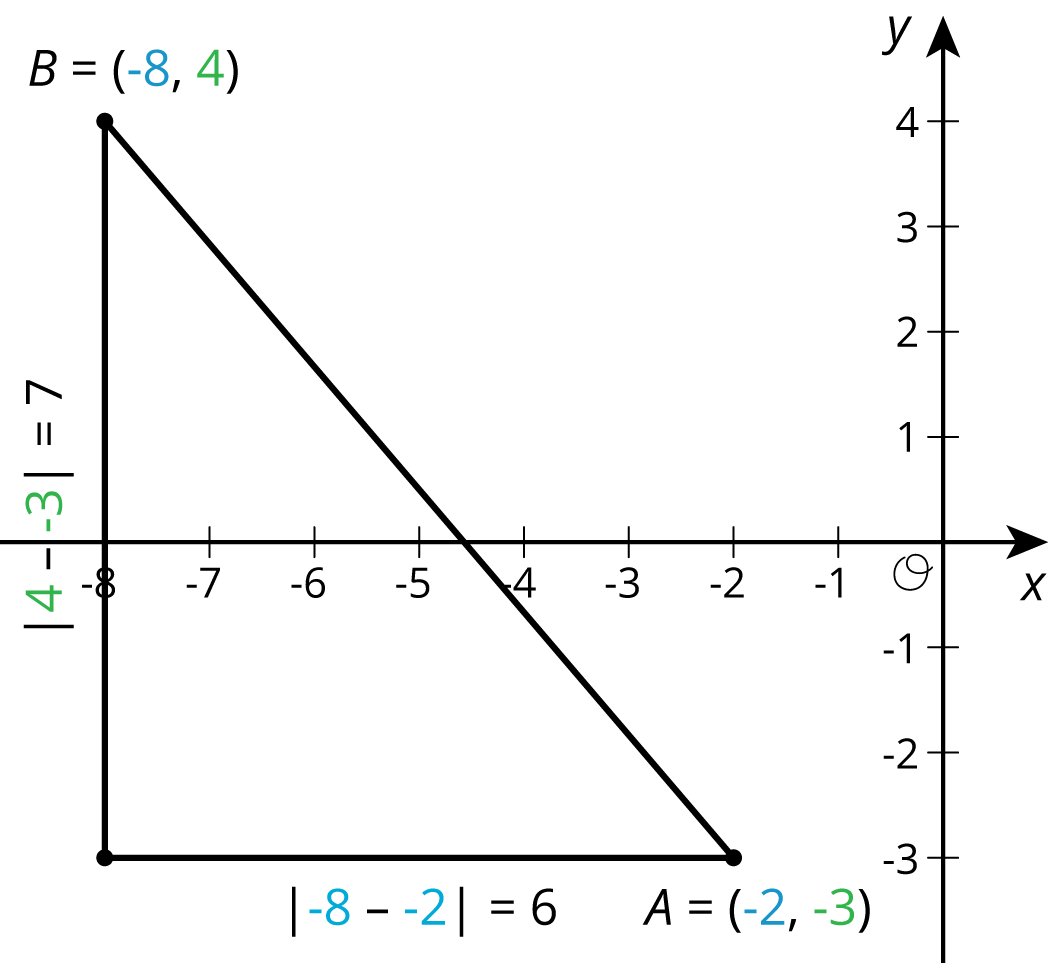Lesson 9
Finding Distances in the Coordinate Plane
9.1: Closest Distance (5 minutes)
Warm-up
The purpose of this warm-up is for students to find the distance between two points on the same horizontal or vertical line in the coordinate plane. Students are given only the coordinates and no graph to encourage them to notice that to find the distance between two points on the same horizontal or vertical line, they subtract the coordinate that is not the same in both points. (This is an idea students should have encountered as early as grade 6.) This understanding will be important for students in upcoming lessons as they begin using the distance formula between two points in the plane as they apply the Pythagorean Theorem.
Launch
Arrange students in groups of 2. Give students 2 minutes of quiet work time followed by 1 minute to compare their responses with a partner. Follow with a whole-class discussion.
Student Facing
- Order the following pairs of coordinates from closest to farthest apart. Be prepared to explain your reasoning.
-
\((2,4)\) and \((2,10)\)
-
\((\text -3,6)\) and \((5,6)\)
-
\((\text -12, \text -12)\) and \((\text -12, \text -1)\)
-
\((7, 0)\) and \((7,\text -9)\)
-
\((1, \text -10)\) and \((\text -4,\text -10)\)
-
-
Name another pair of coordinates that would be closer together than the first pair on your list.
-
Name another pair of coordinates that would be farther apart than the last pair on your list.
Student Response
For access, consult one of our IM Certified Partners.
Activity Synthesis
Invite students to share their order of the pairs of coordinates from closest to furthest apart. Record and display the list for all to see. After the class agrees on the correct order, ask students to share the distance between a few of the pairs of coordinates and their strategy for finding that distance. Ask 2–3 students to share pairs of coordinates they found that would have a closer or further distance than the ones in the list.
If the following ideas do not arise during the discussion, consider asking the following questions:
- “Why does each pair have one coordinate that is the same?”
- “How did you decide on which coordinate to subtract?”
- “Why didn’t you need to subtract the other?”
- “Could we represent this distance with a line segment? How do you know?”
- “Would your strategy work for any pair of coordinates?”
- “Which pairs would it work? Which pairs are we not sure if it would work?”
9.2: How Far Apart? (10 minutes)
Activity
In this activity, students find distances between points in the coordinate plane. The three points are the vertices of a right triangle, helping students to see that they can find the distance between two points that are not on the same vertical or horizontal line by creating a right triangle.
Launch
Arrange students in groups of 2. Give students 2 minutes of quiet work time followed by partner and whole-class discussions.
Supports accessibility for: Organization; Attention
Student Facing
Find the distances between the three points shown.

Student Response
For access, consult one of our IM Certified Partners.
Activity Synthesis
Invite groups to share their solutions. Then draw two points in the coordinate plane, for example \((\text-3, \text-4)\) and \((2,7)\). Ask students how we can use the problem we just solved to find the distance between these two points. If no students suggest drawing the point \((2, \text-4)\), draw it and ask how we can use it to find the distance between the first two points.
Design Principles(s): Cultivate conversation; Maximize meta-awareness
9.3: Perimeters with Pythagoras (15 minutes)
Optional activity
In this optional activity, students calculate the perimeters of two triangles in the coordinate plane using the Pythagorean Theorem. Use this activity if time allows and your students need practice calculating the distance between two points in a coordinate plane.
Launch
Arrange students in groups of 2. Display the image of the two figures for all to see and then poll the class and ask which figure they think has the longer perimeter. Display the results of the poll for all to see during the activity. Tell the class that each partner will now calculate the perimeter of one of the figures.
Supports accessibility for: Memory; Conceptual processing
Design Principles(s): Optimize output (for explanation); Maximize meta-awareness
Student Facing
-
Which figure do you think has the longer perimeter?
- Select one figure and calculate its perimeter. Your partner will calculate the perimeter of the other. Were you correct about which figure had the longer perimeter?

Student Response
For access, consult one of our IM Certified Partners.
Student Facing
Are you ready for more?
Quadrilateral \(ABCD\) has vertices at \(A=(\text -5,1)\), \(B=(\text -4,4)\), \(C=(2,2)\), and \(D=(1,\text -1)\).
- Use the Pythagorean Theorem to find the lengths of sides \(AB\), \(BC\), \(CD\), and \(AD\).
- Use the Pythagorean Theorem to find the lengths of the two diagonals, \(AC\) and \(BD\).
-
Explain why quadrilateral \(ABCD\) is a rectangle.
Student Response
For access, consult one of our IM Certified Partners.
Activity Synthesis
Repeat the poll from the start of the activity to see how results have changed. Select 1–2 students to share their calculations.
9.4: Finding the Right Distance (15 minutes)
Activity
The purpose of this task is for students to think about a general method for finding the distance between two points on the coordinate plane. Students do not need to formalize this into a more traditional representation of the distance formula. In groups of 4, each student will find the distance between two coordinate pairs and then share how they completed their calculations. The coordinates are carefully chosen so that the distances are all equal since each pair represents a possible diameter for a circle centered at \((2,\text-2)\) with radius 5, though students do not need to know this in order to complete their calculations.
Identify students who clearly explain their thinking as they work with their group. Notice any groups that discover the points are all on the perimeter of a circle.
Launch
Arrange students in groups of 4. Tell students that once everyone in their group has calculated the distance between their points they will share how they did their calculations and then answer the problems. Encourage students to listen carefully to the ideas of other members of their group in order to write a clear explanation for the second question.
Supports accessibility for: Language; Social-emotional skills
Student Facing
Have each person in your group select one of the sets of coordinate pairs shown here. Then calculate the length of the line segment between those two coordinates. Once the values are calculated, have each person in the group briefly share how they did their calculations.
-
\((\text -3,1)\) and \((5,7)\)
-
\((\text -1,\text -6)\) and \((5,2)\)
-
\((\text -1,2)\) and \((5,\text -6)\)
-
\((\text -2,\text -5)\) and \((6,1)\)
- How does the value you found compare to the rest of your group?
-
In your own words, write an explanation to another student for how to find the distance between any two coordinate pairs.
Student Response
For access, consult one of our IM Certified Partners.
Activity Synthesis
The purpose of this discussion is for students to compare their methods for finding the distance between two points. Select 2–3 previously identified students to share how they found the distance between their points.
If any groups figured out that the points lie on a circle, ask them to share how they did so. Then, ask students to find the distance between one (or both) of their points and the point \((2,\text-2)\) using the method they described in the second problem. If students calculations are correct, they should get a distance of 5 units, which is the radius of the circle.
Design Principles(s): Cultivate conversation; Maximize meta-awareness
Lesson Synthesis
Lesson Synthesis
The purpose of the discussion is to check student understanding of how to use the Pythagorean Theorem to calculate distances between points in the coordinate plane. Ask:
- “How can you find the distance between points in the coordinate plane?” (If they are on the same horizontal or vertical line, we just subtract the coordinates that are different. If they aren’t, we can construct a right triangle and use the Pythagorean Theorem.)
- “What advice would you give someone finding the distance between two points on the coordinate plane using the Pythagorean Theorem?” (Make a sketch!)
9.5: Cool-down - Lengths of Line Segments (5 minutes)
Cool-Down
For access, consult one of our IM Certified Partners.
Student Lesson Summary
Student Facing
We can use the Pythagorean Theorem to find the distance between any two points on the coordinate plane. For example, if the coordinates of point \(A\) are \((\text-2,\text-3)\), and the coordinates of point \(B\) are \((\text-8,4)\), let’s find the distance between them. This distance is also the length of line segment \(AB\). It is a good idea to plot the points first.

Think of the distance between \(A\) and \(B\), or the length of segment \(AB\), as the hypotenuse of a right triangle. The lengths of the legs can be deduced from the coordinates of the points.

The length of the horizontal leg is 6, which can be seen in the diagram, but it is also the distance between the \(x\)-coordinates of \(A\) and \(B\) since \(|\text-8-\text-2|=6\). The length of the vertical leg is 7, which can be seen in the diagram, but this is also the distance between the \(y\)-coordinates of \(A\) and \(B\) since \(|4 - \text-3|=7\).
Once the lengths of the legs are known, we use the Pythagorean Theorem to find the length of the hypotenuse, \(AB\), which we can represent with \(c\). Since \(c\) is a positive number, there is only one value it can take:
\(\begin{align} 6^2+7^2&=c^2 \\ 36+49&=c^2 \\ 85&=c^2 \\ \sqrt{85}&=c \\ \end{align}\)
This length is a little longer than 9, since 85 is a little longer than 81. Using a calculator gives a more precise answer, \(\sqrt{85} \approx 9.22\).